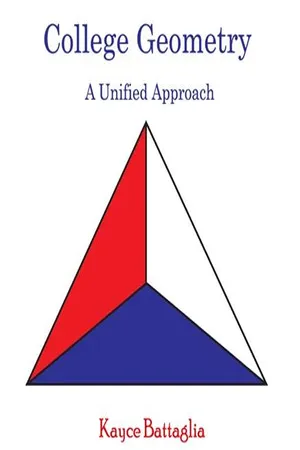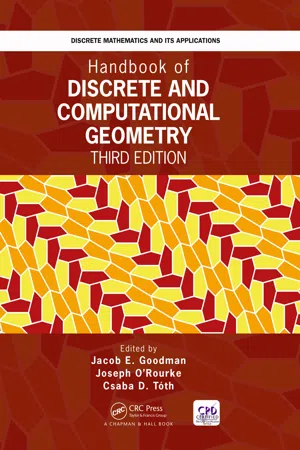Mathematics
Convexity in Polygons
Convexity in polygons refers to the property of a polygon where any line segment connecting two points within the polygon lies entirely within the polygon. A polygon is considered convex if it does not have any indentations or "dents" in its boundary. In other words, all interior angles of a convex polygon are less than 180 degrees.
Written by Perlego with AI-assistance
Related key terms
1 of 5
5 Key excerpts on "Convexity in Polygons"
- eBook - PDF
- Paul S. Heckbert(Author)
- 2013(Publication Date)
- Academic Press(Publisher)
Some degenerate cases. Figure 2. p1 p3 Non-convex polygon with a right turn at each vertex. Although the first two examples might be considered convex (their interior is indeed convex), a majority of the participants in the discussion agreed that these cases should be considered not convex. Further complications are all points collinear and repeated points. What is a convex polygon? This question is very much related to correctness and a suitable definition of a convex polygon was a hotly debated topic. When one thinks about the problem for the first time, a common mistake is to require a right turn at each vertex and nothing else. This leads to the counterexample in Figure 2. Efficiency. The program should run in time proportional to the number of vertices. Furthermore, only constant space for the program was allowed. This required a solution to read the polygon vertices from an input stream without saving them. Imprecise arithmetic. The meaning of three points are collinear becomes unclear when the coordinates of the points are only approximately correct or when floating-point arithmetic is used to test for collinearity or right turns. This article assumes exact arithmetic in order to avoid complications. 0 What Is a Convex Polygon? 0 Answering this question is an essential step toward the construction of a robust program. There are at least four approaches: Ì.2 Testing the Convexity of a Polygon 0 9 Figure 3. An undisputed convex polygon. • The cavalier attitude: I know what a convex polygon is when I see one. For example the polygon in Figure 3 is clearly convex. • The what works for me approach: A polygon P is convex if my triangulation routine (renderer, etc.) which expects convex polygons as input can handle P. • The algorithm as definition approach: A polygon is convex if my convexity testing program declares it as such. - eBook - PDF
Computational Morphology
A Computational Geometric Approach to the Analysis of Form
- G.T. Toussaint(Author)
- 2014(Publication Date)
- North Holland(Publisher)
Computational Morphology G.T. Toussaint (editor) © Elsevier Science Publishers B.V. (North-Holland), 1988 137 ORTHO-CONVEXITY AND ITS GENERALIZATIONS Gregory J. E. Rawlins Department of Computer Science, University of Indiana Bloomington, Indiana, U.S.A. Derick Wood Department of Computer Science, University of Waterloo Waterloo, Ontario, Canada In this paper we report on one aspect of work in progress in restricted-orientation geometry. We investigate various alternative definitions of convexity in this setting rather than the standard definition. At the same time, we indicate how a firm mathematical foundation for these notions can be obtained. 1. Introduction The notion of a convex set has a long and interesting history. Fenchel in his sur-vey paper, Fenchel(1983), traces convexity to a form of proto-convexity in the works of Archimedes! However, it is not until quite recently (early twentieth century) that con-vexity as a unifying notion emerged and found a wide application in the works of Brunn, Minkowski, and others. Still more recently, the young field of computational geometry became interested in and devised algorithms for the computation of convex hulls. But, it was only recently that computational geometry began to consider defini-tions of convexity deemed more appropriate to the field. In several application areas of computational geometry the only lines of interest are orthogonal lines or ortho-lines, that is, lines parallel to the x -or y -coordinate axes. This gives rise, in a natural way, to ortho-polygons (polygons whose edges are orthogo-nal line segments) and so — inevitably — to the question: What is an appropriate defini-tion of a convex set in this setting? Our starting point is the work of Montuno and Fournier (1982), Nicholl, Lee, Liao, and Wong (1983), and Ottmann, Soisalon-Soininen, and Wood (1984). These three groups tried to define an appropriate notion of a convex hull for ortho-polygons and point sets in the plane. - No longer available |Learn more
College Geometry
A Unified Approach
- (Author)
- 2014(Publication Date)
- Orange Apple(Publisher)
________________________ WORLD TECHNOLOGIES ________________________ Chapter- 5 Polygon and Circle Polygon An assortment of polygons In geometry a polygon is traditionally a plane figure that is bounded by a closed path or circuit , composed of a finite sequence of straight line segments (i.e., by a closed polygonal chain). These segments are called its edges or sides , and the points where two edges meet are the polygon's vertices or corners . An n -gon is a polygon with n sides. The interior of the polygon is sometimes called its body . A polygon is a 2-dimensional example of the more general polytope in any number of dimensions. The word polygon derives from the Greek πολύς (many) and γωνία (gōnia), meaning knee or angle. Today a polygon is more usually understood in terms of sides. Usually two edges meeting at a corner are required to form an angle that is not straight (180°); otherwise, the line segments will be considered parts of a single edge. The basic geometrical notion has been adapted in various ways to suit particular purposes. For example in the computer graphics (image generation) field, the term polygon has taken on a slightly altered meaning, more related to the way the shape is stored and manipulated within the computer. ________________________ WORLD TECHNOLOGIES ________________________ Classification Number of sides Convexity Polygons may be characterised by their degree of convexity: • Convex : any line drawn through the polygon (and not tangent to an edge or corner) meets its boundary exactly twice. In other words, all its interior angles are less than 180°. • Non-convex : a line may be found which meets its boundary more than twice. In other words, it contains at least one interior angle with a measure larger than 180°. • Simple : the boundary of the polygon does not cross itself. All convex polygons are simple. • Concave : Non-convex and simple. • Star-shaped : the whole interior is visible from a single point, without crossing any edge. - No longer available |Learn more
- (Author)
- 2014(Publication Date)
- Library Press(Publisher)
________________________ WORLD TECHNOLOGIES ________________________ Chapter 5 Polygon and Circle Polygon An assortment of polygons In geometry a polygon is traditionally a plane figure that is bounded by a closed path or circuit , composed of a finite sequence of straight line segments (i.e., by a closed polygonal chain). These segments are called its edges or sides , and the points where two edges meet are the polygon's vertices or corners . An n -gon is a polygon with n sides. The interior of the polygon is sometimes called its body . A polygon is a 2-dimensional example of the more general polytope in any number of dimensions. The word polygon derives from the Greek πολύς (many) and γωνία (gōnia), meaning knee or angle. Today a polygon is more usually understood in terms of sides. Usually two edges meeting at a corner are required to form an angle that is not straight (180°); otherwise, the line segments will be considered parts of a single edge. The basic geometrical notion has been adapted in various ways to suit particular purposes. For example in the computer graphics (image generation) field, the term polygon has taken on a slightly altered meaning, more related to the way the shape is stored and manipulated within the computer. ________________________ WORLD TECHNOLOGIES ________________________ Classification Number of sides Convexity Polygons may be characterised by their degree of convexity: • Convex : any line drawn through the polygon (and not tangent to an edge or corner) meets its boundary exactly twice. In other words, all its interior angles are less than 180°. • Non-convex : a line may be found which meets its boundary more than twice. In other words, it contains at least one interior angle with a measure larger than 180°. • Simple : the boundary of the polygon does not cross itself. All convex polygons are simple. • Concave : Non-convex and simple. • Star-shaped : the whole interior is visible from a single point, without crossing any edge. - eBook - ePub
- Csaba D. Toth, Joseph O'Rourke, Jacob E. Goodman, Csaba D. Toth, Joseph O'Rourke, Jacob E. Goodman(Authors)
- 2017(Publication Date)
- Chapman and Hall/CRC(Publisher)
30 POLYGONSJoseph O’Rourke, Subhash Suri and Csaba D. TóthINTRODUCTION
Polygons are one of the fundamental building blocks in geometric modeling, and they are used to represent a wide variety of shapes and figures in computer graphics, vision, pattern recognition, robotics, and other computational fields. By a polygon we mean a region of the plane enclosed by a simple cycle of straight line segments; a simple cycle means that nonadjacent segments do not intersect and two adjacent segments intersect only at their common endpoint. This chapter describes a collection of results on polygons with both combinatorial and algorithmic flavors. After classifying polygons in the opening section, Section 30.2 looks at simple polygonizations, Section 30.3 covers polygon decomposition, and Section 30.4 polygon intersection. Sections 30.5 addresses polygon containment problems and Section 30.6 touches upon a few miscellaneous problems and results.30.1 POLYGON CLASSIFICATION
Polygons can be classified in several different ways depending on their domain of application. In chip-masking applications, for instance, the most commonly used polygons have their sides parallel to the coordinate axes.GLOSSARY
- Simple polygon: A closed region of the plane enclosed by a simple cycle of straight line segments.
- Convex polygon: The line segment joining any two points of the polygon lies within the polygon.
- Monotone polygon: Any line orthogonal to the direction of monotonicity intersects the polygon in a single connected piece.
- Star-shaped polygon: The entire polygon is visible from some point inside the polygon.
- Orthogonal polygon: A polygon with sides parallel to the (orthogonal) coordinate axes. Sometimes called a rectilinear polygon.
- Orthogonally convex polygon: An orthogonal polygon that is both x - and y -monotone.
- Polygonal chain: A sequence of connected, non-self-intersecting line segments forming a subportion of a simple polygon’s boundary. A chain is convex or reflex if all internal angles are convex or reflex respectively.
Index pages curate the most relevant extracts from our library of academic textbooks. They’ve been created using an in-house natural language model (NLM), each adding context and meaning to key research topics.




